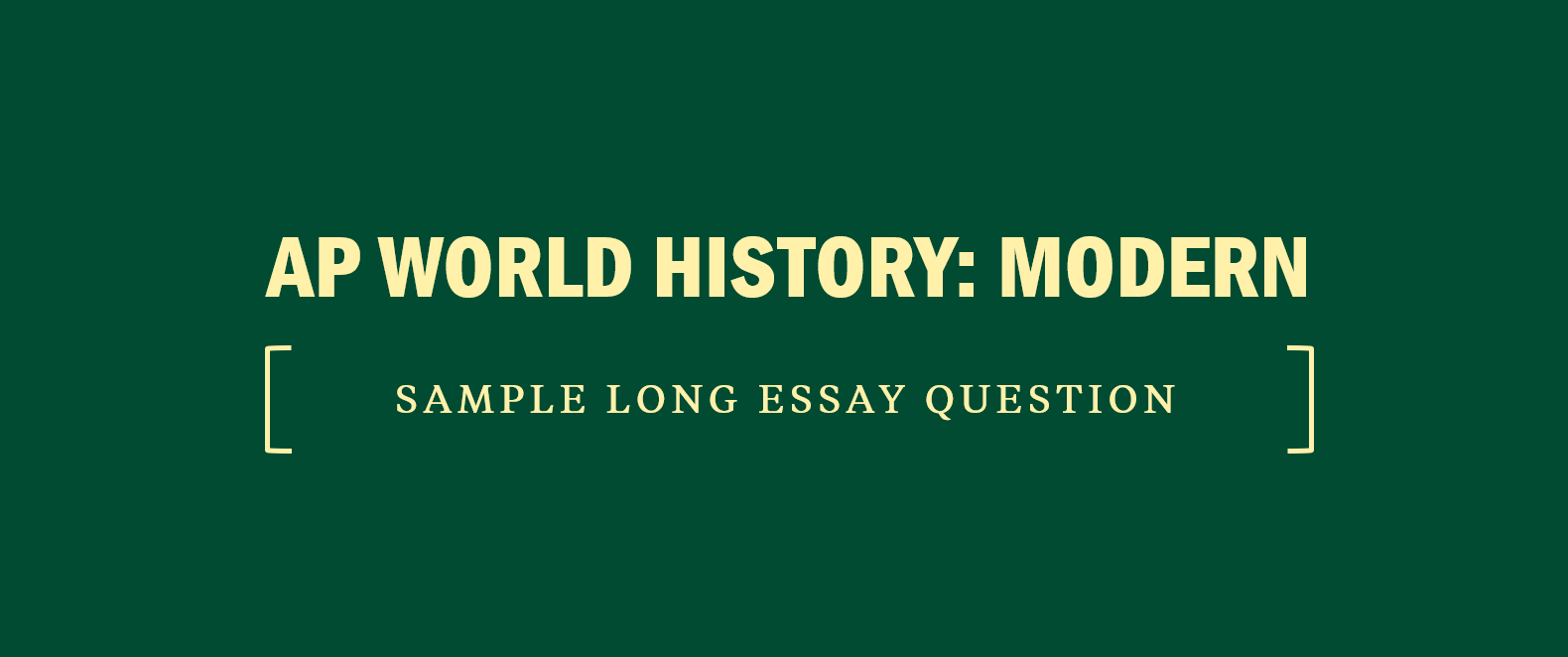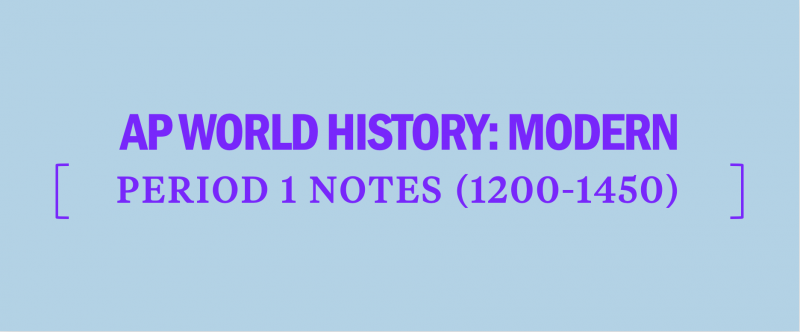
- AP Calculus
- AP Chemistry
- AP U.S. History
- AP World History
- Free AP Practice Questions
- AP Exam Prep


AP World History: Modern Sample Long Essay Question
In the period 1850 to 2001, new technologies emerged that had significant social, political, and economic effects. Develop an argument that evaluates the extent to which changes in the spread of ideas/information before and after World War I impacted societies.
Step 1: Analyze the Prompt
As you choose which question you will answer, begin thinking about what your thesis will entail and how your essay will demonstrate a complex understanding. The notes of a sample high- scoring writer are below. Note that the writer plans to develop a complex argument by addressing not only changes, as required by the prompt, but also continuities in societies before and after World War I.
Thesis : changes: faster spread of ideas made news, politics, and war more immersive and fast-paced; continuity: cross-cultural interactions transform all cultures (complex understanding, historical skill)
Step 2: Plan Your Response
- Context : Gutenberg → 2nd industrial revolution (steamship, train, telegraph) → digital revolution (radio, TV, Internet)
- Thesis : changes: faster spread of ideas made news, politics, and war more immersive and fast-paced; continuity: cross-cultural interactions transform all cultures ( complex understanding, historical skill )
- Evidence : War of 1812 versus WWII, Vietnam, Gulf War
- Evidence : American Revolution versus Cold War
- Evidence : language: Arab traders & Swahili, and modern business & English
- ¶ conclusion: impacts of tech on society have become more pervasive, though tendency towards cross-cultural influence has persisted
Step 3: Action! Write Your Response & Step 4: Proofread
Sample high-scoring response.
A key change between these eras of communication is how the speed of ideas’ dissemination impacts their force of impact and makes news more pervasive in civilians’ lives. In the distant past, the slow rate of communication caused reactions that were often months, or even years, after the initial communication. For instance, the final battle of the War of 1812 was fought after the signing of the war’s peace treaty because news had not yet traveled by ship across the Atlantic Ocean. In contrast, the peace treaties of WWII were celebrated in cities around the world mere minutes after news of their signing was shared by telegram and radio signals. The quick spread of images and video from the Vietnam conflict helped intensify Americans’ resistance to the war. In recent decades, 24-hour live coverage of conflicts, as in CNN’s being the first to provide constant coverage of a war during the Gulf War, allowed policy- makers and civilians to respond instantly to developments. As news became quicker, so its impact became more significant and more immediate.
Another change is that the quick and pervasive spread of ideas has made political conflicts more ideological and propaganda-based, further drawing societies into global disputes. Political rebellions of the eighteenth century, such as the American and French Revolutions, were based on Enlightenment ideals such as equality and representative government; they made use of propaganda in the form of printed political cartoons, tracts, and engravings to spread their ideals among the populace. However, the news communication made possible by radio and television after World War II helped propel the ideological conflict between the communist Soviet Union and the democratic United States into a worldwide phenomenon that intensely impacted both nations’ citizens. Technology was able to so effectively spread this war of ideas that the two major superpowers never engaged in direct battle themselves; still, citizens were drawn into a culture of propaganda that demonized the other side, made bomb shelters and bomb drills a part of daily life due to fear of nuclear warfare, and saw governments pour millions of dollars into the space race. Technology thus made it possible for conflicts to become all-immersive, even if they were based on ideas rather than physical confrontations.
Despite changes in communication, constants about its impacts remain. Cross- cultural communications still transform societies as they borrow and adapt ideas from others. For instance, from the eighth century onward, Arab traders who traveled throughout West Africa and along the eastern and northern coasts not only enriched communities economically but also spread Islam. Further, the necessity for communication among traders led to the rise of Swahili, a language that combined Arabic and African words and is still the lingua franca in much of East Africa today. Similarly, in modern times, as Britain and then the United States dominated world trade, English became a kind of worldwide lingua franca of modern business. Just as Arab traders spread their religion, American culture also diffused to other societies: almost every nation in modern times, for instance, built American-style fast food restaurants. Mirroring the trends related to the spread of news and politics, cultural diffusions in recent decades occurred at a faster rate and to a more pervasive extent than in the past. Whereas primarily traders would have adopted Swahili as it developed over generations, today English is taught in grade schools throughout the world.
Cultures that interact always influence each other. In the past century, how- ideas travel at a faster pace. As they have in ever, technology has made the impact of this spread of ideas more pervasive and significant as news and political the past, societies will continue to transform as they encounter ideas from other cultures, but with this increased intensity of communication, the impacts of ideas will continue to escalate.
You might also like

Call 1-800-KAP-TEST or email [email protected]

Prep for an Exam
MCAT Test Prep
LSAT Test Prep
GRE Test Prep
GMAT Test Prep
SAT Test Prep
ACT Test Prep
DAT Test Prep
NCLEX Test Prep
USMLE Test Prep
Courses by Location
NCLEX Locations
GRE Locations
SAT Locations
LSAT Locations
MCAT Locations
GMAT Locations
Useful Links
Kaplan Test Prep Contact Us Partner Solutions Work for Kaplan Terms and Conditions Privacy Policy CA Privacy Policy Trademark Directory

AP World History Long Essay Question Example 1
Have you written out your own response to the first of our AP World History Long Essay Questions ? Below you can review a sample answer and evaluate what earns this AP World History LEQ example a perfect score.
Evaluate the impact of the trans-Saharan trade routes on the exchange of goods, cultures, and ideas in Africa and the Islamic world during the period c. 1200–1750. Analyze the role of trade networks in shaping societies and economies during this era.
Sample Answer:
Thesis/Claim (1 point): The trans-Saharan trade routes played a pivotal role in facilitating the exchange of goods, cultures, and ideas between regions in Africa and the Islamic world during the period c. 1200–1750, leading to significant economic, cultural, and technological advancements. Contextualization (1 point): Before the emergence of the trans-Saharan trade routes, both Africa and the Islamic world experienced dynamic historical developments. In Africa, the Kingdom of Ghana flourished as a major trading empire, while in the Islamic world, the spread of Islam led to increased cultural diffusion and intellectual growth. These developments set the stage for the establishment of the trans-Saharan trade networks. Evidence (2 points): The trans-Saharan trade routes facilitated extensive exchanges between regions. One specific example of this exchange is the trade of gold from West Africa for salt and textiles from North Africa. The availability of gold in West Africa, particularly in the Mali Empire, spurred demand for North African goods. This trade not only enriched both regions economically but also led to cultural exchanges. Furthermore, the introduction of new crops such as sorghum and millet to West Africa from the Islamic world improved agricultural practices, leading to increased food production and population growth. Another significant development is the spread of Islam along these trade routes. As merchants and traders traveled across the Sahara, they also brought Islamic culture and religion with them. This resulted in the conversion of some African societies to Islam, creating a cultural and religious connection between regions. Additionally, the construction of notable centers of learning such as Timbuktu in Mali became hubs for intellectual exchange, where scholars from Africa and the Islamic world gathered to share knowledge. Analysis and Reasoning (2 points): The trans-Saharan trade routes not only connected regions economically but also fostered cultural and intellectual exchanges. This is evident in the adoption of Islamic practices and the establishment of centers of learning in West Africa. Furthermore, the trade in goods such as gold and salt played a vital role in the economic development of both regions. To achieve a more complex understanding, it’s essential to consider that while the trans-Saharan trade routes brought about positive exchanges, they also had challenges, such as the harsh desert environment and the impact on local communities. Nevertheless, the overall impact was largely beneficial, contributing to the growth and interconnectedness of African and Islamic societies. In conclusion, the trans-Saharan trade routes during the period c. 1200–1750 were instrumental in promoting economic, cultural, and intellectual exchanges between regions in Africa and the Islamic world. This interconnectedness resulted in mutual enrichment and the spread of Islamic culture and knowledge.
Total Points: 6
This essay provides a historically defensible thesis, relevant contextualization, specific evidence, and a well-structured analysis, earning a perfect score according to the AP World LEQ Rubric.
When you are finished with LEQ question 1, proceed to the next sample answers to review other strong essays or return to the main menu with the buttons below.

IMAGES
VIDEO
COMMENTS
Test your AP knowledge with a sample AP World History: Modern Long Essay Question. Get strategies, answer explanations & more.
Download free-response questions from past AP World History exams, along with scoring guidelines, sample responses from exam takers, and scoring distributions.
In the twentieth century, governments responded to economic crises in various ways. Develop an argument that evaluates the extent to which governments (other than the United States government) changed their economic policies in response to the Great Depression. Reporting Category. Scoring Criteria.
Provide a historically defensible thesis or claim that establishes a position on the extent to which European imperialism affected economies in Africa and/or Asia in the nineteenth and early twentieth centuries.
The thesis must suggest at least one main line of argument development or establish the analytic categories of the argument. The thesis must consist of one or more sentences located in one place, either in the introduction or the
This essay provides a historically defensible thesis, relevant contextualization, specific evidence, and a well-structured analysis, earning a perfect score according to the AP World LEQ Rubric.